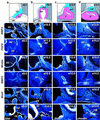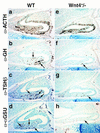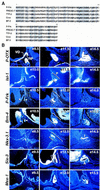Multistep signaling requirements for pituitary organogenesis in vivo
- PMID: 9620855
- PMCID: PMC316866
- DOI: 10.1101/gad.12.11.1691
Multistep signaling requirements for pituitary organogenesis in vivo
Abstract
During development of the mammalian pituitary gland specific hormone-producing cell types, critical in maintaining homeostasis, emerge in a spatially and temporally specific fashion from an ectodermal primordium. We have investigated the molecular basis of generating diverse pituitary cell phenotypes from a common precursor, providing in vivo and in vitro evidence that their development involves three sequential phases of signaling events and the action of a gradient at an ectodermal boundary. In the first phase, the BMP4 signal from the ventral diencephalon, expressing BMP4, Wnt5a, and FGF8, represents a critical dorsal neuroepithelial signal for pituitary organ commitment in vivo. Subsequently, a BMP2 signal emanates from a ventral pituitary organizing center that forms at the boundary of a region of oral ectoderm in which Shh expression is selectively excluded. This BMP2 signal together with a dorsal FGF8 signal, appears to create opposing activity gradients that are suggested to generate overlapping patterns of specific transcription factors underlying cell lineage specification events, whereas Wnt4 is needed for the expansion of ventral pituitary cell phenotypes. In the third phase, temporally specific loss of the BMP2 signal is required to allow terminal differentiation. The consequence of these sequential organ and cellular determination events is that each of the hormone-producing pituitary cell types-gonadotropes, thyrotropes, somatotropes, lactotropes, corticotropes, and melanotropes-appear to be determined, in a ventral-to-dorsal gradient, respectively.
Figures








Similar articles
-
Multistep signaling and transcriptional requirements for pituitary organogenesis in vivo.Recent Prog Horm Res. 2000;55:1-13; discussion 13-4. Recent Prog Horm Res. 2000. PMID: 11036930 Review.
-
Hedgehog signaling is required for pituitary gland development.Development. 2001 Feb;128(3):377-86. doi: 10.1242/dev.128.3.377. Development. 2001. PMID: 11152636
-
Signaling mechanisms in pituitary morphogenesis and cell fate determination.Curr Opin Cell Biol. 1999 Dec;11(6):669-77. doi: 10.1016/s0955-0674(99)00034-4. Curr Opin Cell Biol. 1999. PMID: 10600709 Review.
-
Noggin regulates Bmp4 activity during pituitary induction.Dev Biol. 2007 May 1;305(1):145-60. doi: 10.1016/j.ydbio.2007.02.001. Epub 2007 Feb 7. Dev Biol. 2007. PMID: 17359964 Free PMC article.
-
Temporal regulation of a paired-like homeodomain repressor/TLE corepressor complex and a related activator is required for pituitary organogenesis.Genes Dev. 2001 Dec 1;15(23):3193-207. doi: 10.1101/gad.932601. Genes Dev. 2001. PMID: 11731482 Free PMC article.
Cited by
-
Patterning osteogenesis by inducible gene expression in microfluidic culture systems.Integr Biol (Camb). 2011 Jan;3(1):39-47. doi: 10.1039/c0ib00053a. Epub 2010 Oct 5. Integr Biol (Camb). 2011. PMID: 20924519 Free PMC article.
-
The notch target gene HES1 regulates cell cycle inhibitor expression in the developing pituitary.Endocrinology. 2009 Sep;150(9):4386-94. doi: 10.1210/en.2009-0206. Epub 2009 Jun 18. Endocrinology. 2009. PMID: 19541765 Free PMC article.
-
Impaired FSHbeta expression in the pituitaries of Foxl2 mutant animals.Mol Endocrinol. 2011 Aug;25(8):1404-15. doi: 10.1210/me.2011-0093. Epub 2011 Jun 23. Mol Endocrinol. 2011. PMID: 21700720 Free PMC article.
-
All Hormone-Producing Cell Types of the Pituitary Intermediate and Anterior Lobes Derive From Prop1-Expressing Progenitors.Endocrinology. 2016 Apr;157(4):1385-96. doi: 10.1210/en.2015-1862. Epub 2016 Jan 26. Endocrinology. 2016. PMID: 26812162 Free PMC article.
-
Congenital Hypopituitarism During the Neonatal Period: Epidemiology, Pathogenesis, Therapeutic Options, and Outcome.Front Pediatr. 2021 Feb 2;8:600962. doi: 10.3389/fped.2020.600962. eCollection 2020. Front Pediatr. 2021. PMID: 33634051 Free PMC article. Review.
References
-
- Basler K, Struhl G. Compartment boundaries and the control of Drosophila limb pattern by hedgehog protein. Nature. 1994;368:208–214. - PubMed
-
- Bellusci S, Henderson R, Winnier G, Oikawa T, Hogan BL. Evidence from normal expression and targeted misexpression that bone morphogenetic protein (Bmp-4) plays a role in mouse embryonic lung morphogenesis. Development. 1996;122:1693–1702. - PubMed
-
- Bellusci S, Furuta Y, Rush MG, Henderson R, Winnier G, Hogan BL. Involvement of Sonic hedgehog (Shh) in mouse embryonic lung growth and morphogenesis. Development. 1997;124:53–63. - PubMed
-
- Bieberich C, Fujita K, He W, Jay G. Prostate-specific and androgen-dependent expression of a novel homeobox gene. J Biol Chem. 1996;271:31779–31782. - PubMed
Publication types
MeSH terms
Substances
Associated data
- Actions
LinkOut - more resources
Full Text Sources
Molecular Biology Databases
